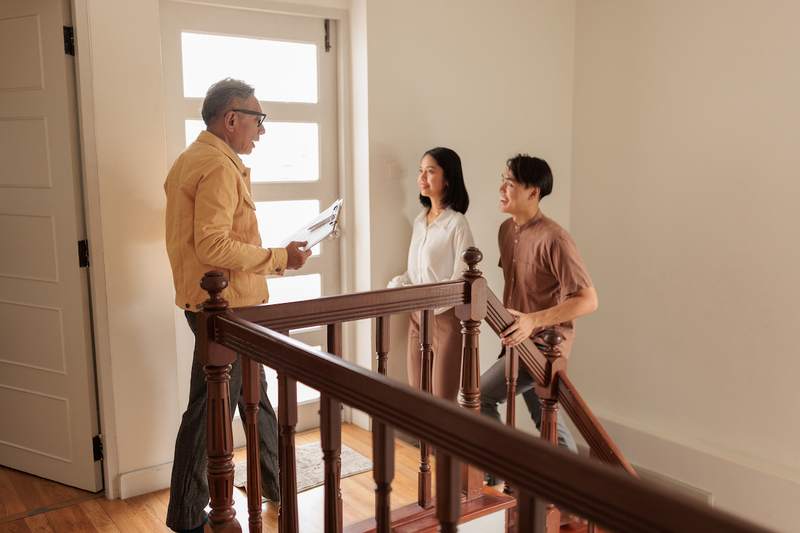The most obvious difference between renting vs. buying a home is that you make a mortgage payment to your mortgage lender instead of paying rent to the property owner each month. But if you’re used to renting, you should know there are extra costs to consider when buying a house.
Jules Borbely, a strategic real estate consultant for Real Estate Bees and COO of Oxford Property Group based in New York City, says that the biggest misconception first-time homebuyers have is that they only have to think about paying property taxes and the mortgage each month.
“Buyers often realize the true cost of homeownership too late, and get blindsided by the unexpected bills,” he says.
Key Takeaways:
- The “hidden” costs of buying a home include loan costs, title costs, documentation costs, property costs, and third-party services.
- The “hidden” costs of owning a home include insurance, taxes, homeowners association fees, emergency repairs, exterior maintenance, landscaping, interior maintenance, and utilities.
‘Hidden’ Costs of Buying a Home
When you buy a home, you need to make a down payment and pay closing costs. Some closing costs seem manageable on their own, but they add up quickly.
Here’s a rundown of the different costs you might pay when you close on your new home. The details of your home purchase and the property itself will determine which costs you have to pay, and which are optional. You can expect to pay between 2% and 5% of your loan amount in closing costs.
Loan costs
1. Application fee. You may need to pay a nonrefundable fee to process your mortgage application, which can cost up to $500.
2. Assumption fee. A mortgage assumption is when the buyer takes over the seller’s loan. If you assume a conventional loan, you likely will need to pay the lender $800 to $1,000, or 1% of the mortgage amount.
3. Credit reporting fee. The lender pulls your credit score to approve you for your mortgage. Each credit report costs $10 to $100.
4. Discount points. Buying points means you’re paying interest upfront to reduce the interest rate on your loan. The amount you pay depends on your lender’s rates and how many points you decide to buy.
5. Escrow funds. You likely need to pay the first several months of property taxes and homeowners insurance into your escrow account to close the sale.
6. Origination fee. This fee covers the lender’s cost to set up your loan, which is generally about 1% of the total loan amount.
7. Prepaid interest. This covers the interest that accrues between closing on your loan and your first monthly mortgage payment.
8. Rate lock fee. You pay this fee to your lender to lock in your interest rate for the period between mortgage preapproval and closing. Some lenders will lock your rate for free, but other times it can cost 0.25% to 0.5% of the total value of the loan.
9. Underwriting fee. Some lenders split the origination fee into an underwriting fee and a processing fee. For your mortgage to be approved, an underwriter must review your income, assets, and debts to verify that you can afford the loan, and to evaluate how much of a risk you pose to the lender. This may cost up to $1,000.
10. Federal Housing Administration mortgage insurance. If you have an FHA loan, then you’ll need to pay a mortgage insurance premium of 1.75% of your loan amount.
11. Department of Agriculture guarantee fee. USDA loans require that you pay a loan guarantee fee upfront in exchange for the government backing. This costs up to 3.5% of the total loan amount.
12. Veterans Affairs funding fee. VA loans require a funding fee. If you put at least 10% down, then the fee is 1.4% of the total loan amount; if you put at least 5% down, then your fee is 1.65%; and if you put less than 5% down, then the fee for first-time VA borrowers is 2.3%.
Title costs
13. Title search fee. A title search is performed to detect claims, liens, or unpaid taxes on the property. This fee typically costs anywhere from $75 to $400.
14. Lenders title insurance. Expect your mortgage lender to require lenders title insurance, which protects the lender in case there’s a legal challenge to the home’s title. The cost ranges from $500 to $1,000, depending on the home.
15. Owners title insurance. Owners title insurance covers you against any claims or past liens on the home’s title. The cost ranges from $150 to $1,000, depending on the home.
Documentation costs
16. Courier fee. This fee is charged to transport your mortgage paperwork, and usually costs around $30.
17. Notary fee. If you sign your loan documents outside of the escrow office, you’ll likely need a notary. Fees vary widely, but expect to pay about $100 to $150.
18. Recording fee. This fee costs about $125 and covers registering and recording your home sale in public records.
Property costs
19. Appraisal fee. Before you close on your home, a home appraisal will be ordered to assess the property’s market value. The average appraisal typically costs $300 to $600 for a single-family residence, though it can vary based on the home’s size and location.
20. Flood certification fee. You may have to pay a fee of between $15 and $35 to the Federal Emergency Management Agency to verify whether your property is in a flood zone.
21. Home inspection fee. Not to be confused with the appraisal, the home inspection evaluates the condition of the home to make you aware of any damage or safety concerns. The inspection typically takes place after you sign the purchase agreement. The average home inspection costs $300 to $500, according to the Department of Housing and Urban Development.
22. Lead-based paint inspection fee. Homes built prior to 1978 may contain lead paint and require an inspection that costs roughly $300.
23. Pest inspection fee. Some states require a pest inspection. You also may need one if you have a VA loan. This costs about $100.
24. Survey fee. The survey details your property lines and includes any known easements that give other parties the right to use your property. The survey fee can cost anywhere from $200 to $1,000.
Third-party services
25. Moving service fee. You can hire professionals to help you move. It’s usually about $600 to $2,000.
26. Attorney fee. This covers the cost of reviewing and creating legal documents by an attorney. You’ll spend about $500 to $1,500.
27. Closing or escrow account fee. This typically costs 1% to 2% of the home purchase price.
28. Real estate agent commission. This generally costs 5% to 6% of the total loan value and is usually factored into the asking price. The total is split between the buyer’s agent and the seller’s agent.
29. Broker commission. After the real estate agent commission is split, it may then be divided again between the broker and buyer’s agent.
30. Home warranty services. This covers the repair and replacement of appliances, and costs $80 to $125 a month.
‘Hidden’ Costs of Owning a Home
After you close on the home and move in, there are a number of ongoing costs you’ll face as a homeowner. Some will be recurring, such as utilities, property taxes, and homeowners insurance. Others will be one-time expenses, but they could catch you by surprise and be expensive.
Here are some of the additional costs of owning a home.
Insurance
31. Homeowners insurance. This policy helps protect you from the financial consequences of potentially catastrophic events, like storms, fires, or theft. It also provides liability protection if someone sues you over an injury that occurred on your property. You’ll typically be required to pay your first year of coverage as part of your closing costs. Expect to pay about $1,000.
32. Flood insurance. This covers flood damage and can cost $800 to $1,200 per year.
33. Earthquake insurance. Prices can vary widely for this, from $800 to $5,000 per year. Whether you purchase flood and earthquake insurance will depend on if you live in a place vulnerable to these natural disasters. Note that flood and earthquake coverage are not included in a standard homeowners insurance policy, and need to be purchased separately.
34. Private mortgage insurance. If your down payment on a conventional loan is less than 20% of the purchase price, then you’ll need to pay for PMI to protect the lender in case you stop making payments.
35. Landlord insurance. This protects against property damage, liability, and loss of income if a rental home is damaged by catastrophe. This can apply if you buy a multifamily property, and is typically a bit more expensive than a homeowners policy. If you’re living in a single-family home, you don’t need this.
36. HO7 insurance. This is specialized home insurance for mobile homes or manufactured homes and costs about $300 to $1,300 per year.
Taxes
37. Property tax. Local governments collect property taxes, so the amount you pay varies depending on where you live. In addition to the property tax rate in your area, what you owe is based on the value of your home. “Annual property taxes average about 1% of the home value nationwide,” says Robert Ingram, a certified financial planner at the Center for Financial Planning in Southfield, Michigan.
38. Tax monitoring and research fees. This covers the cost of hiring someone to confirm all taxes on the home are paid and the tax is properly calculated. The price will depend on the provider that your lender chooses.
39. Transfer tax. You likely have to pay a transfer tax to get your home’s title updated and transferred to you. This fee is paid to your local government.
Homeowners association fees
40. Homeowners association fees. If your home is a condominium or located in a community with an HOA, then you’ll likely need to pay a monthly or annual fee to cover the maintenance of common areas and shared amenities, such as swimming pools and security gates. HOA dues also often cover certain utilities, such as water, trash removal, and sewage. “Depending on the amount of amenities and, of course, the location, the average association (or) condo fees range from $200 to $400 per month,” Ingram says.
41. Homeowners association transfer fee. Some HOAs charge a fee when a home is sold. The fee is usually about $200 or $250, but can vary. Usually the seller pays the fee, but the buyer could offer to pay to sweeten the deal.
Emergency repairs
When you’re renting a home and there’s a plumbing emergency, the property manager typically arranges and pays for repairs. But when you’re a homeowner, emergency repairs are your responsibility.
Depending on the extent of the damage, repairs can be expensive — and time sensitive. If your central heating system breaks down in wintertime or a pipe bursts, you’ll need to hire someone to fix it immediately.
Some common emergency home repairs you may face include:
42. Burst, broken, or clogged pipes. This can cost between $150 and $5,000, depending on the severity of the damage.
43. Roof damage. A typical fix will cost about $1,000 but could be much higher.
44. Water damage. If your home is damaged by water, you can expect to pay $3 per square foot to $7 per square foot of damaged area.
45. Foundation repair. The foundation supports the load of your home and keeps you safe. Repairs cost an average of $5,000.
46. Broken furnace. The cost to replace depends on the type of furnace. Electric furnaces cost $1,500 to $2,500, while oil systems can cost nearly double that amount.
47. Broken air-conditioning system. Repair costs depend on the type of system you have, and can range from $2,000 to $10,000 or more.
48. Electrical issues. Costs will vary depending on the issue. A simple rewiring or panel repair can cost $1,500 or more.
49. Broken water heater. This provides hot water for your whole house and costs between $800 and $1,700 to replace.
50. Septic system repair. You only need to worry about this if you use a septic system instead of a sewer. Repairs can cost about $1,750.
51. Broken windows. New windows can improve energy efficiency. Expect to pay between $175 and $1,200 per window.
52. Insect extermination fees. A one-time visit can cost $300 to $550. Ongoing service will run you about $50 per month.
53. Mold removal. Mold can cause serious health issues, so it’s important to remove it immediately. The average cost is $2,000 but can be more for serious issues.
Exterior maintenance
If you currently rent, then you’re probably used to the property owner paying maintenance costs. For example, you might pay your utility bills, but the property owner maintains the building exterior and takes care of upkeep, like plumbing or fresh coats of paint.
Owning your home means that you’re responsible for routine maintenance, which isn’t as simple as paying a fixed amount every month.
“Consider the tools and equipment you would need to buy, or the services you would hire to do the work,” Ingram says.
54. Trash collection. This is often either charged as part of your property taxes or included in homeowners association fees. Expect to pay between $25 to $100 per month.
55. Painting the exterior. A fresh coat of paint can make your home look great but set you back about $3,000.
56. Deck or patio maintenance. Repairing an existing deck or patio costs about $2,000. Adding one from scratch is much more costly at $17,000.
57. Fences. Fences offer privacy, and you can expect to pay between $1,700 and $4,400 for a new one, depending on the size and quality of the fence.
58. Siding and awnings. Keeping your siding and awning in good condition is important for weatherproofing. Repairs or replacements cost about $25 per square foot.
59. Pool or spa maintenance. Pools are a great way to cool down in the summer but can cost $80 to $200 per week, unless you’re willing to maintain the pool yourself.
60. Pest control. Rats and other pests can chew through wires, creating fire hazards and other dangers. Hiring an exterminator will cost about $200 to $600.
61. Solar panel installation. Solar panels are increasingly popular as a way to go green and save on electric bills. A typical system costs $3 per watt to $5 per watt of capacity, leading to a cost of $15,000 to $25,000 before tax incentives.
Landscaping
The condition of the grounds contributes to your home’s value, so it’s important to keep things tidy. Depending on where you live, you may also have to consider the costs of:
62. Lawn care. Lawn care can include anything from regular mowing to fertilizing and watering. Expect to pay about $125 per visit.
63. Snow removal. If you live in a cold climate, this can save you the trouble of shoveling snow after every storm. Expect to spend $350 to $450 per year.
64. Tree trimming. Trimmed trees will keep your home looking nice and safe from falling branches. This service usually costs about $200 to $750.
Interior maintenance
65. Paint. Painting the interior of a house typically costs around $2,000.
66. Appliances. New appliances can help your home be more energy-efficient. Prices range depending on what you’re buying. For example, a new high-end fridge can cost $8,000, but a new low-end dryer can cost $400.
67. Floors and carpets. New flooring or carpets can cost about $3 per square foot to $11 per square foot.
68. Furniture. This cost can vary depending on your budget. Homeowners spent an average of $2,701 a year on furniture and appliances in 2021.
69. Security system. Security systems protect your home and family from intruders. Systems range from $50 to $1,000 or more, while monitoring services cost about $100 to $500 per year.
70. Lights. Good lighting is important to make your home feel inviting. Ceiling lights generally cost $90 to $230 to install.
Utilities
As a renter, you may already be used to paying for certain utilities, such as electricity and gas. Homeowners typically must cover all the costs involved with running their homes, which will likely be an increase from what you currently spend on utilities.
The size and location of your new home also affect your utility bills. Moving from an 800-square-foot apartment to a 2,500-square-foot house could double or triple your energy costs, according to Ingram. Once you’ve factored in the fees for your water and sewage services, your utilities could exceed $500 per month, he says.
You can expect the following recurring utility bills with these approximate costs:
71. Electricity. This bill costs about $117.46 per month.
72. Gas. This bill costs about $67.28 per month.
73. Water. This bill costs about $45.44 per month.
74. Sewage. This bill costs about $66.20 per month.
75. Internet. This bill costs about $61 per month.
76. Cable or satellite TV. This bill costs about $114 per month.
The Bottom Line on the ‘Hidden’ Costs of Homeownership
The “hidden” fees of buying a house can put you over budget and under financial pressure. The homebuying process on its own already involves certain fees to close the sale and get the property officially in your name. Once you’re living in your new home, you’ll face maintenance and utility costs, along with homeowners insurance and property taxes. You also may have to pay regular HOA fees.
The true cost of homeownership is the sum of your mortgage and all these additional costs. Some of them will become typical monthly expenses, while others — like accidental damage — could show up unannounced. By planning for these “hidden” costs when you’re buying a home, you can be better prepared to expect the unexpected.
T.J. Porter contributed to the reporting of this article.






